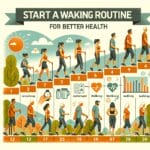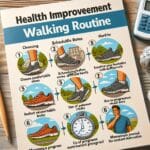https://weightliftingforpower.com/how-to-start-a-walking-routine-for-better-health/
You might not give it much thought, but walking is a remarkably effective form of exercise. Consider its broad-ranging advantages:Start walking can bolster heart health, assist in weight management, and enhance mental wellbeing.


Now, despite its simplicity, walking is often overlooked. Maybe because it’s something we do without effort, we assume it can’t make much difference. However, research begs to differ. Studies show a consistent walking routine can significantly lower the risk of chronic diseases.
You can meet the CDC’s guidelines for moderate-intensity aerobic activity by engaging in activities like brisk walking for at least 150 minutes each week. Implementing a walking routine can be your stride towards meeting this guideline and improving your health.
I’m not just presenting a general health principle; I aim to create a road map for you to build and maintain a walking routine. This approach isn’t about intense workouts but about integrating a practical, enjoyable, and sustainable activity into your life for long-term benefits.
Identifying Your Personal Walking Goals
Before you lace up your sneakers and step out the door, it’s crucial to consider what you aim to achieve with your walking routine. Having clear, personalized goals can transform your walks from aimless strolls to powerful tools for your health.
Are you walking to shed a few pounds, maintain weight, or improve cardiovascular fitness? You may be interested in the mental clarity of a brisk morning walk or the peace of a leisurely evening saunter. Recognize what you want to get out of your walking routine; this understanding will guide the ‘how’ and ‘when’ of your steps.
If you’re new to walking for exercise, start with manageable targets. For instance, aim for a 15-minute walk on most days of the week and incrementally build up. Regularity is more beneficial than intensity when you’re just starting.
I recommend keeping a simple log of your walks. Note how far you went, how you felt, and anything notable about the walk. It doesn’t have to be elaborate—a straightforward notepad or a digital app will do the trick. Celebrate small victories; perhaps you walked five minutes longer than last time or chose to take the stairs. These are the kinds of progress worth acknowledging.
Next, I’ll guide you through building this routine into a sustainable part of your lifestyle. We’ll discuss the practical details of setting yourself up for success and how you can stay influenced by making each walk enjoyable and varied.
Creating a Sustainable Walking Routine


Once you’ve set clear personal goals for your walking routine, the next step is to establish a sustainable plan. Your success in maintaining a walking routine rests on your ability to integrate it into your daily life.
Proper footwear is critical. I cannot stress enough how comfortable walking shoes can make or break your experience. Ill-fitting or inappropriate shoes can lead to injuries that may derail your efforts. Investing in good-quality footwear pays off not just in comfort but also in protecting your feet and joints.
It’s wise to start slowly, especially if you’re new to regular exercise or returning after a break. You could begin with a brisk 10-minute walk each day and gradually increase the duration by five minutes weekly until you can comfortably walk for 30 minutes or more.
To keep your routine engaging, change your routes often. Walking the same path every day can become tedious. Exploring new neighborhoods or taking on park trails inject variety and revitalization into your routine.
Safety should never be an afterthought. Always pick well-lit, safe paths for your walks, and if you’re venturing out early in the morning or after dark, wear reflective gear. Share your walking plan with someone if you’ll be in a secluded area.
Consistency is the backbone of any routine. Aim to walk simultaneously daily to help it become a habitual part of your schedule. On days when time is short, a shorter walk is better than none—keep up the habit.
Building a walking habit isn’t a race; it’s about cultivating a part of your lifestyle that can last for years. As you walk toward better health, this simple practice will be a cornerstone for a healthier, happier life.
Maximizing Health Benefits Through Complementary Practices
So, you’ve laced up your shoes and stepped into a healthier routine with your new walking regimen. That’s great! But there’s more to it than just putting one foot in front of the other. To reap the full spectrum of benefits walking offers, consider pairing your endeavors with complementary health practices.
Optimal health requires a balanced diet, hydration, and mind-body practices like yoga and meditation.
Remember, stretching isn’t just a prelude to your walk; it’s a crucial component that prepares your muscles, reducing the risk of injuries. Moreover, including some strength training exercises on alternate days can fortify your legs, making your walks more efficient and increasing their health benefits.
Remember to appreciate the power of a supportive community or simply walking with friends or family. This interaction can turn exercise into a social event, increasing your commitment and, arguably, making it more enjoyable.
Lastly, rest is as important as activity. Taking rest days helps your body to recover from physical exertion, making you stronger and more resilient. Please pay close attention to your body’s signals and give it the necessary downtime. It will help avoid overexertion and potential injury, ensuring that your walking routine remains a sustainable and beneficial part of your healthy lifestyle.
